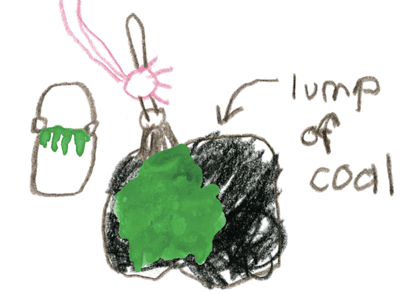The Colour of Money
Darrell Harvey

Illustration by Dave Donald
Marketers will slap the “green” label on just about anything. Don’t be fooled
I have no qualms with calling myself a conscious consumer. If there’s a label, I read it. If there’s not, I ask. I like to know what’s in the products I buy, where they come from, and who made them. I care about the price, sure, but I also care about the environmental and social impacts of the global supply chain that brought them from the field or factory to my shopping cart. I don’t want my jeans sewn by a 12-year-old girl, an oldgrowth tree felled so I can blow my nose in Kleenex-y comfort, or my tomatoes shipped to my plate from halfway around the world.
And, these days, there’s a good chance you don’t either. A quarter of American adults are what Hugh Hough calls “awakening consumers.” The president of Green Team, a New York-based communications and advertising agency that specializes in environmental issues, says shoppers who realize they can effect change through their everyday purchases are wielding more and more power in the marketplace. With billions of dollars of ethical consumer spending up for grabs, it’s not surprising some of the world’s biggest companies are scrambling to get a piece of the eco-friendly pie.
But how can consumers sort legitimate green claims from false advertising — making sure their choices have an impact — given the number of companies that boast eco-friendly products?
Take Procter & Gamble, for example. The consumer-products giant plans to spend US$20 billion over the next five years developing and marketing eco-friendly products. Household staples such as Charmin toilet paper and Bounty paper towels now come with more sheets per roll to reduce waste. A truly eco-friendly choice would be, of course, to simply wipe up the spill with an old rag. But you can’t sell that for $1.99.
P&G isn’t the only company reaching for our green dollars: I can buy recycled gift paper and eco-beauty products at Pistachio, a new retail offering from Heather Reisman of Indigo Books fame; I can light my home with energy produced by “clean coal”; and my grocery store tempts me with something new and organic (and usually vacuum-packaged) on the shelf every week. Everything from cars to coffee to nuclear power is being peddled as green consumer choices.
Of course, any environmentalist will tell you that coal isn’t clean and nuclear power isn’t green. So why are they being sold as such? Because they can.
It’s called greenwashing, and it’s a major obstacle for eco-conscious consumers. TerraChoice Environmental Marketing Inc. defines greenwashing as the act of misleading consumers about the environmental practises of a company or the environmental benefits of a product or service.
Its 2007 study of more than 1,000 consumer products found all but a handful guilty of overplaying their environmental benefits in one of several “sins” of greenwashing — making irrelevant claims; being vague, offering no proof; or other forms of deception. Many ordinary products were simply relabelled with environmentally friendly-sounding slogans.
Chevrolet is one of my personal favourites. In an industry that has emitted more carbon out of its collective tailpipe than perhaps any other, the company’s 2009 marketing tagline is “gas-friendly to gas-free.” The vehicles in its latest lineup are the very same (minus the much-anticipated Volt electric car) it sold in the past, except back then most of their ads touted their speed and powerful engines — hardly eco-friendly.
Much of today’s green marketing is more about branding than anything brand new. So what’s a conscious consumer to do? Enviro-marketing experts say the best thing is to reward companies that are transparent. Mountain Equipment Co-op, for example, recently published the locations of its offshore suppliers, among the first clothiers in Canada to do so. Similarly, Timberland puts a “nutritional label” on its boxes of shoes, spelling out the company’s environmental, labour, and community impact statistics. Regulation is coming, but slowly.
Companies in Canada face new guidelines for marketing environmental messages recently released by the Competition Bureau and the Canadian Standards Association. While the guidelines are voluntary, violators accused of false advertising face fines or removal of their products from store shelves. Certified eco-labelling agencies, such as EcoLogo and Green Seal, are also good measures of authenticity.
In the end, the best way to vote with your dollars for a more sustainable world is simply to buy less. After all, buying more stuff, even if it’s “green” stuff, is still more stuff. Stuff that costs the planet resources to make, to ship, to clean, to store, and ultimately to dispose of. And you don’t need a label to know that.